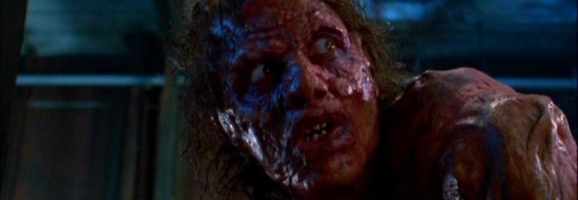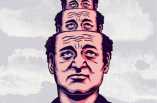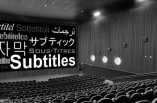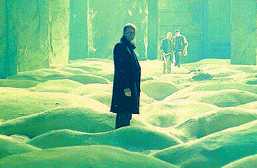Is Narrative Overrated? Finding New Ways to Engage With Cinema

Having recently studied Back to the Future on my degree course, a film which has never had a much of an effect on me, I was amazed at just how many people describe its wonderful escapist qualities. I find this interesting because Back to the Future has always had the opposite effect on me – creating a feeling of detachment due to its predictability. I could say the exact same thing about films like Jurassic Park, The Goonies, and Star Wars. For those suffering from a similar feeling of dissatisfaction, who, like me, are more excited about the release of The Zero Theorem than Guardians of the Galaxy; I hope to provide a few alternative ways to lose yourself in cinema.
1. Aesthetic and Narrative Innovation

Personally, I find the most satisfying films are ones that offer unpredictability and originality. Instead of the déjà vu of a conventional narrative, some films manage to surpass this by providing something much more enigmatic. There are many auteurs that can be linked to this form of cinema, including David Lynch, Stanley Kubrick, and Andrei Tarkovsky, but I think one particularly interesting director working in cinema today is Shane Carruth. His films Primer and Upstream Colour have taken the art form out of the restrictions of convention and into the realm of something purely cinematic. Films of this type are often criticised for being style over substance or unashamedly pretentious. Although, to prioritise narrative would be to stick to the restrictions of theatre and novels when something much more expressive has the potential to be created through the medium.
The music and editing in Carruth’s films largely contribute to their overall effect and they create an almost transcendent feeling. These are experiences more than stories. There is also a definite sense of rewatchablity due to their enigmatic elements and lack of clear resolution. This is not to say that they are without meaning or completely avant-garde; Primer is a complex time travel story which becomes more and more comprehensible upon repeat viewings.
It is misleading to suggest that the makers of these films do not achieve a great amount of success. All of the directors listed above have large fan-bases, but, to generalise a little, these tend to be avid cinephiles more than the average cinemagoer. It has become commonplace for their work to be labelled as ‘arty’ or outside of popular culture; despite their significance in film history and the influence their imagery has had on pop culture (Kubrick is particularly notable in this regard).
In terms of specific examples of aesthetic innovation, some recent films worth mentioning are Antiviral and Only God Forgives. Both of these are beautifully shot and provide ways to engage with cinema through the beauty of the image alone.
Other examples: In the Mood For Love, Werckmeister Harmonies, A Scanner Darkly, The Thin Red Line, The Assassination of Jesse James By the Coward Robert Ford, The Tree of Life, Last Year in Marienbad, The Face of Another, Pi, Melancholia, Eyes Wide Shut
2. ‘Trippy’ Cinema

This category consists of bizarre cinematic experiences that are so otherworldly they create the feeling of drug-induced states. The work of Gaspar Noé is frequently referred to in relation to this, but I think another great example is the recently overlooked Beyond the Black Rainbow. Heavily criticised for its lack of narrative or explanation, it plays out like a music video using abstraction, combined with a heavy soundtrack and flawless cinematography. Another great example is Requiem For A Dream, which sets up a clear conflict between its anti-drug narrative and drug-replicating aesthetic.
I think Noé’s Enter the Void is one of the most escapist masterpieces ever made as it never expects you to focus on the details of character or narrative, the performances leave a lot to be desired and its pacing is varied, but this allows the viewer to completely lose themselves in the sound and imagery alone. A lot of these films could be linked back to the work of many avant-garde artists over the years who have attempted to create a similar feeling through image and sound. Often these works can have the opposite effect and be too jarring to find a way into. Personal preference and experience are everything, which explains why reactions can be so mixed.
Dystopian settings can also have trippy effects and transport the viewer to another world that is far removed from reality. These films can of course still have strong narrative ties but they are never limited solely to this. Blade Runner and Brazil are the first that come to mind but this is not only limited to science fiction; Lynch’s Eraserhead is one of the finest examples of a dystopian nightmare that revels in its ambiguity and expects the viewer to let it wash over them rather than become invested in narrative; Beyond the Black Rainbow is also very similar in this sense. The horrific elements of trippy escapism also tie nicely into the next category.
Other examples: Fear & Loathing in Las Vegas, Spring Breakers, 8 ½, The Fantastic Planet, 2001: A Space Odyssey, The Holy Mountain, Naked Lunch, Tetsuo: The Iron Man, Solyaris, Easy Rider, Donnie Darko, Mulholland Drive, Lost Highway, Twelve Monkeys
3. Shocking Cinema and Body Horror

Fascination is key when it comes to escapist cinema and this is a fundamental element of body horror and torture porn genres. The grotesque has the ability to repel some and absorb others. It is can also be purely cinematic in many ways. The camera can linger voyeuristically as Jeff Goldblum pulls off his fingernails in The Fly or hurl the audience towards Bruce Campbell as cuts off his arm in Evil Dead II; either way, these are moments of gruesome spectacle but also pure visual pleasure for any horror fan. The excess of horror often takes on a life of its own outside of narrative. Torture porn takes this to extreme lengths, at the name suggests, and crudely pushes the viewer to breaking point through an excess of unpleasant imagery. Recent French shockers, Martyrs, Inside, and Frontier(s), are all clear examples of this.
This type of horror has become even more pronounced in the postmodern era. The Cabin the Woods literally throws every possible piece of horror imagery at its audience for their satisfaction. Another interesting thing about this film is that it appears to have a very conventional horror narrative at the beginning but subverts this with a heavy dose of self-awareness, later undermining all narrational and character development. The ‘releasing of the monsters’ sequence is set up for niche audiences to revel in. Postmodernism has led to a whole new form of cinema in itself with the viewer’s pre-existing knowledge creating a new form of engagement.
Other examples: The Shining, Kill List, The Human Centipede, Scream, Carnival of Souls, Suspiria, Phenomena, The Tenant, Tokyo Gore Police, Possession
4. Postmodernism and Genre Revisionism

Postmodern cinema priorities visual pleasure in a similar way to body horror, although it can work in different ways, as satisfaction often comes from the reference tied to the image more than the image itself. Quentin Tarantino is one of the most widely regarded postmodern directors but these films are not simply products of auteur cinema. A rather controversial, but also valid, example of this is Showgirls and its relation to All About Eve. For those of you who enjoy this film, and other forms of paracinema or exploitation movies, it could be because it takes the set-up of a classical Hollywood film and recycles it into something overtly exploitative and just plain crazy at times. The same could be said in relation to Natural Born Killers which draws on classics like Badlands and turns it up to eleven. Again, excess and spectacle are key to audience satisfaction but expectation and pre-existing knowledge also play a big role when it comes to postmodern cinema.
One way I have often applied this to myself is in relation to melodrama. I find Douglas Sirk’s films to be particularly unpalatable yet absolutely adore the work of Pedro Almodovar. The only way I have ever been able to explain this is that Almodovar takes the established conventions of melodrama and self-awarely moulds them into something original. There is a sense of unpredictability and beauty to his melodramas, making them more than simple imitations, and original works in their own right.
Comedy is another genre that has benefited from the postmodern treatment. The ‘existential comedy’ is one of the finest sub-genres to emerge in recent times, taking comedy in new, more ‘intellectual’ directions. I Heart Huckabees is a great example of this as it is very much out for laughs but is also a deep philosophical study that utilises the cinematic image to present its abstract ideas. Genre revisionism can be very enjoyable for those familiar with classical filmic structures and is a way for directors to take something old and mould it into something new.
Other examples: Kill Bill, Amelie, Garden State, 500 Days of Summer, Synecdoche New York, Lost in Translation, Scream, American Beauty
Hopefully I have managed to provide a few alternatives for those of you looking to escape from the restrictions of narrative cinema. I think it’s important to remember that, as an audio-visual medium, cinema has the ability to break free from these restrictions and certain filmmakers have consistently proved this. It’s a shame that art films are often lumped into one category when they deserve to be sub-categorised as much as genre pictures.
What do you think? Leave a comment.











Great article! I am not very well versed in film, but this article has definitely opened a few doors for me. I hope to begin my journey with the suggestions listed here! Although I may stay away from the torture porn.
The Holy Mountain is an awesome movie i recooment. I’ve watched it a number of times and still find it trippy beyond belief. I’m still not sure what it all means though.
I would also like to submit The Devils, Taxidermia, Eraserhead, and Science of Sleep.
The Holy Mountain, The Devils, and Eraserhead are all in my favourite films 🙂 I must see Taxidermia and The Science of Sleep.
I’m a big fan of the work of Jim Jarmusch, Down By Law being a favourite.
I enjoy the slow, contemplative tone of his films and the weird and interesting characters he develops in collaboration with the interesting actors he chooses.
I haven’t managed to get my girlfriend to sit through a whole one yet though.
Dogville. My first introduction to Lars Von Trier. I picked it up in some 5 for £20 sale at HMV because the plot sounded pretty interesting. I got home and thought “What the Hell is this?” About 3 hours later, I was amazed. I had never seen a movie like it. I’ve since watched all of Von Trier’s work. I know the guy polarizes opinion, but for me, he’s an excellent film-maker.
Good call on Dogville, an absolute masterpiece. Any movie that could attract Nicole Kidman, Lauren Bacall, John Hurt and James Caan on a shoe-string budget (supposedly Kidman’s hair-dresser was paid more than she was) had to be something special.
I challenge anyone to track down El Topo or Un Chien Andalou, just about anything by Luis Bunuel. Lisztomania or Repo Man.
El Topo is such a great film. Very epic, very large, all-encompassing, and dreamlike. I prefer Fellini’s Satyricon, and I find it odd that both films are not better known to film students.
Well I’m a film student and I’ve seen both 🙂 Satyricon is highly underrated imo
Narrative is certainly not overrated, but it’s always good to introduce people to different cinematic approaches. Recently I’ve been obsessing over the work of Ryan Trecartin, and I recommend looking into his work if you’re at all interested in video art. “A Family Finds Entertainment” is a good place to start, and if you’re more ambitious I would check out his new work from the recent Venice Biennale.
Also, I’m surprised how many of my favorite films you’ve managed to include in this list. Oh, and that includes star wars 😛
I know the feeling of boredom with movies because of predictability. This seems like a paradox, but I feel as if you explain the lack of interest and failure of traditional movies to capture the viewer’s attention. This article also is very accurate in naming ways to get lost in movies again. I will definitely be looking for movies with these aspects in the future.
Some of my recommendations:
Barton Fink (1991)
The Acid House (1998)
Bug (2006)
Enter the Void (2009)
Jacob’s Ladder (1990)
Nine Miles Down (2009)
One Point O (2004)
The Signal (2007)
Spun (2002)
Incidentally saw “Only God Forgives” recently and that to me was a perfect example of what can often go wrong in this genre (if I understand the genre correctly) pure style over content. There are interesting elements sure, but mainly the film is akin to listening to a band tune up a snare drum for forty minutes and experiment with the perfect level of fuzz on the bass for another hour, for a pay off a great riff for thirty seconds. I’ll have the riff please, not the tortuorous hours getting to it.
Only God Forgives aims far too high for its own good. It attempts to explore religion, power, and morality, but ends p being an exercise at staring at Ryan Gosling’s face…Drive is much better because it doesn’t bite off more than it can chew.
Good post. I like how you focused on films that were interesting in the way that they approached postmodernism rather than just good films that happened to be postmodern
Can I make a plea for Subway? It was the first film I saw with subtitles. Isabelle Adjani and Christopher Lambert look gorgeous. The whole movie has the depth of the teaspoon but somehow I managed to watch it three times.
The Spirit of the Beehive & The South by Víctor Erice are two of the most uniquely beautiful and haunting films I’ve ever seen. If he had made more films I’m certain he would be as acclaimed as Kubrick & Bergman.
few to add to the list:
Delicatessen
Bodies, Rest and Motion
Wings of Desire
Three colours white
Equinox
Leolo
Lost Highway
Drowning by Numbers
L.627
Belle de Jour
Betty Blue
Subway
Dog Tooth
Almost anything by Bela Tarr (respect, JaredB)
Il Conformista
Persona
Death of a Chinese Bookie
Performance
L’Avventura
I’m not sure if it counts as an arthouse film, but Synecdoche, New York is perhaps the greatest film I’ve ever seen. Utterly devastating, yet beautiful at the same time, and in such a way that it never seems gloomy – even the most brutal scenes are somehow sweet, uplifting.
Also, there’s a film called Pontypool which any fan of intelligent cinema should see. It’s difficult to describe – all I can say is that it’s mind-bending in the best way possible.
I saw Pontypool a long time ago but I remember really enjoying it and being pleasantly surprised.
Spring, Summer, Autumn, Winter… and Spring.
Beautiful and with barely a word spoken. Exceptional.
An absolute masterpiece. I adore Korean cinema 🙂
“Enter the void” was really intense. But don’t get the extended version if you catch it.
Enter the Void is an extremely powerful movie experience. It is a fantastic movie, albeit painful. Recommend watching it alone if possible.
I do agree on how so many narrative films can be generalized because they are so similar and predictable. I personally like those narrative films that can catch a general audience’s attention and interest, yet still be artistic and meaningful enough for film nerds like me to analyze on. Like the Dark Knight, Prestige, Her.
What…no Michael Bay film? Just kidding, nice read.
This is a well written article and includes some of my favourites as well!
Upstream Color is one of the most innovative films in recent memory, and I agree with what you say about Carruth. I think he’s brilliant and one of the top minds in cinema right now. I have no doubt his third film will be even better.
I also think Antiviral is an amazing atmospheric film.
Splendid article Alice. It really made me wonder why I enjoy the films that I do. Truth be told, there’s no real sense of unity in the films that I watch. The Avengers is just as fun to watch for me as Magnolia. In the end, I don’t think it’s not the narrative that I care about, but rather what the narrative means to me. The wisdom that a film is able to give us is what leads me to decide whether I like or dislike a movie. Eboni Navarro posted that he/she liked Dogville, but I couldn’t stand the picture. There were themes there that certainly made me think but the manner in which the story was presented was far too distracting to like. Moreover, it didn’t really connect with the story that was being told. Conversely, a movie like The Tree of Life has tons of meaning because of the images chosen and how they relate to the overall theme of the film which is the eternal battle between nature and grace. Again, terrific article. Thanks a bunch for the movie recommendations too, I’ll be sure to check them out sometime 🙂
Thank you, much appreciated 🙂 and yes, I agree, I do think personal preference has a lot to do with it.
Except maybe point 3, all of these are what I’m looking for in cinema.
How can I explain to some why my favs are 8 1/2, Ereaserhead, Stalker, Kubrick, Noe, Tarr, then 500 days of summer and Spring breakers all at the smae time ? This article saves me a lot of work :>
Try Costa’s Collosal Youth too, it should make this list.
My top100 list if someone cares :> http://quotily.wordpress.com/favorites-rankings/top-100-favorite-movies/
People always complain that Hollywood never does anything new, which it has been that way since movies started, so they look for new sources of movies. However, in turn they begin to take these “Unique” ideas and they become unoriginal.
This article gives me hope that other people are interested in the same movies as me. I recently watched ‘Syndromes and a Century’ with a friend and she was bored out of her mind but I was enthralled and enraptured. Perhaps this is because I’ve seen all of the great narrative films I’m supposed to have seen and catch the well-reviewed, Oscar-bait films in theaters, but I’ve simply become bored with narrative cinema. Maybe I’ve just run out of narrative films to watch. In any event, this article is a reminder that there is indeed more out there. One of the things I find comforting, in particular, is that after all I’ve seen, I still have so much more to watch and look forward to. In short, for as long as I get to live, I’ll never watch it all.
Great article. The most recent film that I have seen that directly challenges conventional ideas of what a film is supposed to do is the documentary Leviathan. There is no narrative, and there is no narration. There are only images and sounds, and the filmmakers edit these materials together to create a visceral symphony for the senses.
A filmmaker whom I adore for his unique approach to cinematic language is Abbas Kiarostami. His films (including Close-Up, Certified Copy, and Like Someone in Love) are all visually enthralling, and his narratives are always surprising and unlike anything else out there.
Spike Lee’s older films may deserve a second look. He was great at breaking the form of traditional cinema and over saturating and even cross processing scenes to provide impact or disrupt the narrative.
I don’t know how you can label “Back to the Future” as predictable and enjoy “Kill Bill (vols 1 & 2).” You lost me there. 🙁
Your article was interesting because it addresses one of the most important focal point of all artistic media – namely, the status of narrative/plot/story. It seems to me that the problem you address isn’t narrative per se, but bad narrative – narrative that is predictable, unoriginal, and/or conventional. For those of us who see a lot of movies, I don’t think it’s a stretch to say that the vast majority just aren’t very good, especially in terms of the plot, and logical inconsistencies within that plot. I agree that this is a problem and is the basis of why so many movies fail in one way or another.
But does this mean that narrative per se is the problem? Granted that movies are an “audio-visual medium,” it does not follow that they should be devoid of some type of narrative. After all, reading a book is a visual act as well, and while some may think that plot is unimportant, the vast majority read fiction because it does tell a story. This is even the case of a purely audio medium, music. Classical composers certainly thought they were “telling” a story in the music they composed. And even popular music tells some sort of story through the lyrics. Whatever one thinks about country music, the reason it is the single most popular music genre is because country music knowingly adheres to the formula of presenting a narrative. (See The NPD Group for the stats on country music’s popularity.) The same is true of theater, which is also an audio-visual medium. This also doesn’t mean that the strictly visual or audio aspects of film should not be important – they should, and they should complement the plot, enhance it, bring those virtues inherent in it to the story.
My point is that there is something about human beings, in whatever culture you’d like to look at, that one could say “demands” a narrative/story/plot. I’m with Aristotle who considered plot to be the single most important element of a drama (in his case tragedy), and who thought that a plot must have a beginning, a middle, and an end, although these do not have to take place in this linear way. It just means that the events of the plot must relate to one another as being either necessary or plausible. And from a more modern view, a view of the evolution of human beings, Jonathan Gottschall wrote a book in 2012, The Storytelling Animal, which argues that telling stories is part of the package of what it is to be human; humans and narrative went hand in hand, co-evolved, as it were. We cannot not do without it.
Of course, as you say, many plots/narratives are hackneyed, trite, unoriginal, and stale. The same for most of the lyrics of popular songs. This doesn’t mean we don’t want or like narrative, it means that the vast majority of narratives created for popular culture are, well, terrible.
Thank you for your comment. I think you make an interesting point there that I mostly agree with. In fact, I find that because I have so much appreciation for films I consider to be masterpieces I actually spend most of the time actively disliking the majority of films I watch. Essentially it is my love of those with great audio-visual qualities and narratives that makes me quite fussy. As you say, the majority just aren’t that good but that makes finding the good ones all the more satisfying.
It is interesting that most of the films you listed actually follow a pretty standard formula to some degree, especially in the writing. With independent cinema on the rise again, the “experimental narrative” is becoming pretty popular, but then films like Requiem for a Dream or Kill Bill aren’t at all what I would consider experimental in any way, in fact, they are absolutely narrative. Part of the reason the films you mentioned are so popular now is because, yes, they take the traditional formulas of the last 100 years and mixed different techniques and aesthetics, but they still aim at telling a story. Character, plot, and setting. You are getting at a good point for sure, there need to be other branches of film than just the traditional, however, I honestly think you need to branch out a little more if these are your idea of “non-narrative” films. Try Stan Brakhage, Stacy Steers, Chris Sullivan, or Don Hertzfeld, they work with experimental narrative as well as the literal aspects of what film can stand – that’s what experimental narrative does is not only show a story in a different way, but incorporates the physical side of film as well. Hope this helps!
I have actually studied filmmakers like Stan Brakage (I did an avant-garde module last year). Although personally I’m not a huge fan of films that are purely experimental like that. My real point is that there are some great films out there that do still conform to some of the structural elements of mainstream cinema but use aesthetic innovation to transcend their restrictions.
I’m so glad I came across this article. I am on Fall break and I’ve been watching a ton of movies, most of which seemed to be dull and predictable. I researched other types of movies that would provide me with the intellectual stimulus that I crave, and I kept seeing the same directors: David Lynch, Stanley Kubrick, Andrei Tarkovsky, and more recently, Lars von Trier.
So thanks a ton for your input!
P.S. I watched Eraserhead, 120 Days of Sodom, Antiviral, Antichrist, and A Clockwork Orange all in one day. I had a lot of trippy nightmares that night.
… I bet
But aren’t all dreams “trippy”? Ha
Yeah I think any mind would be slightly disturbed, at least longer than normal if one decided to take a dark stimulation bath such as you described.
Since there is now an accepted “Genre Revisionism”, and since genres create, or at least, partake in authoring, culture, can such revisions be made to culture itself?
In theory, it’s not a far fetched concept; I’m just applying the same logic “genre revisionism” uses to culture, which art produces emotionally. Then Narrative Ethics come in: can we begin to start sub cultures, genres, and start telling tales of this and that when it will have a global effect, since we’re all connected virtually now?
This all seems a bit strange but global communication is also a recent feat of humanity, what’s next is up to us.
“The future starts today, not tomorrow” – Saint JP II
Cheers,
Nick